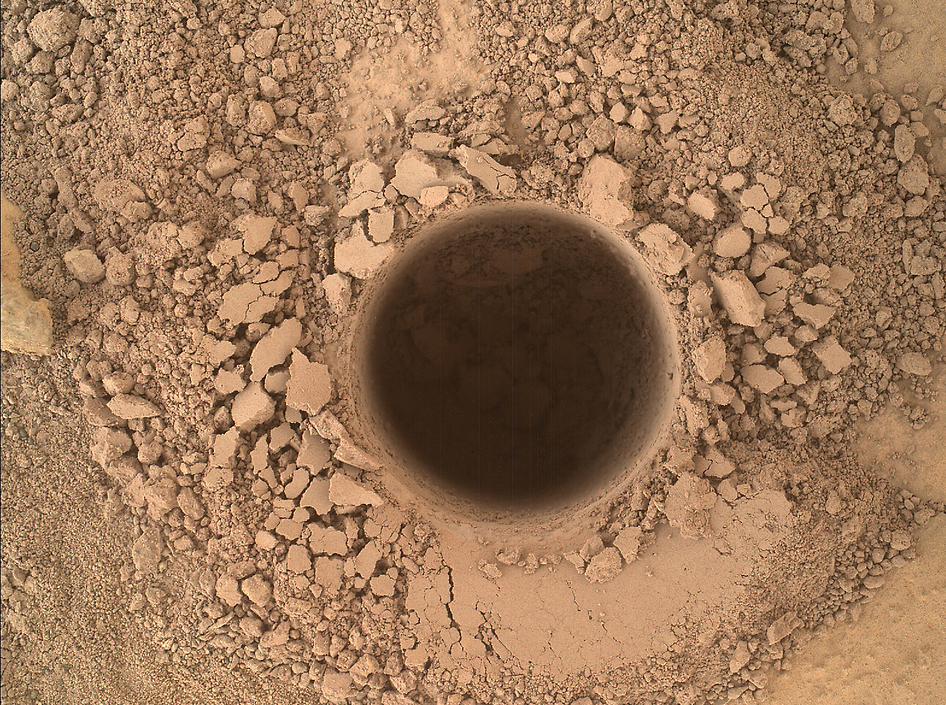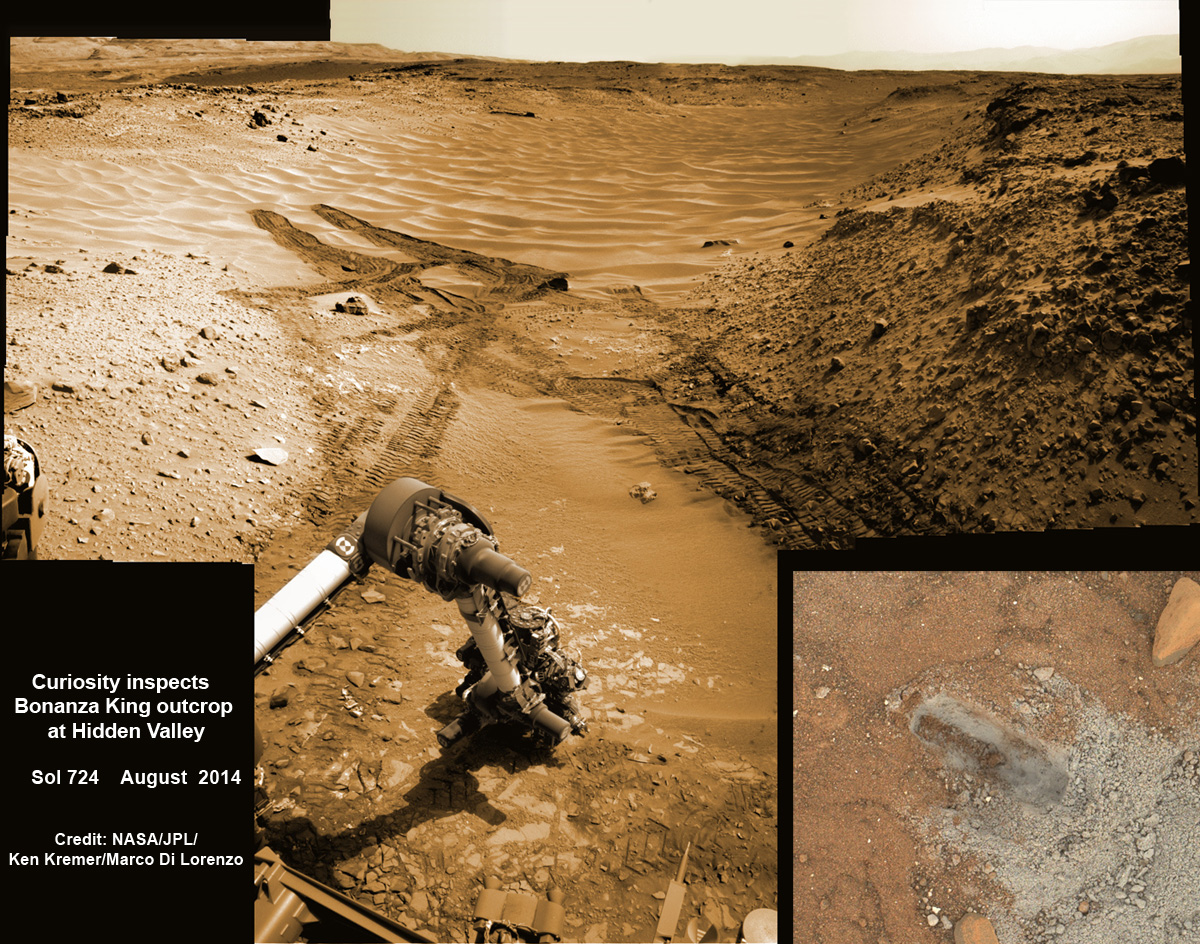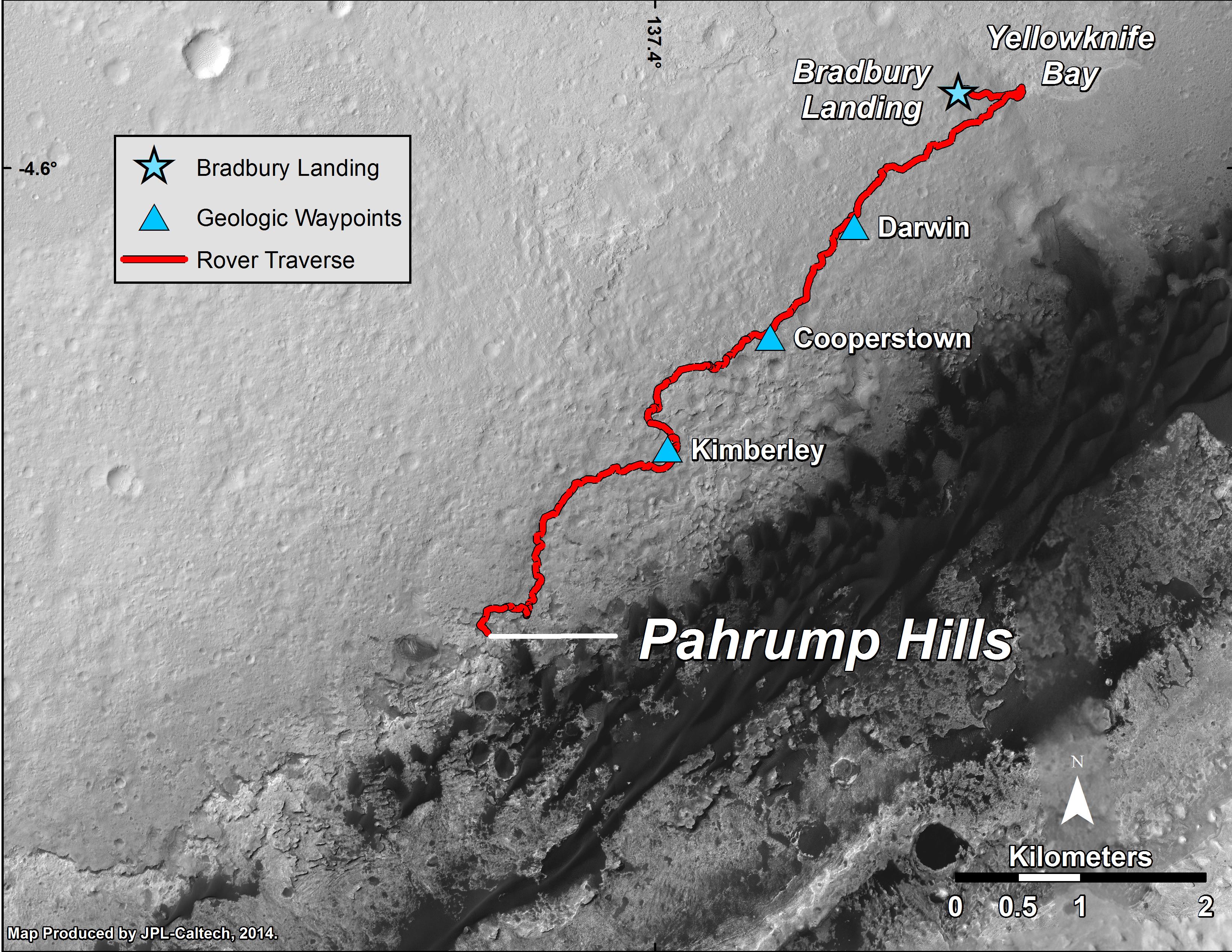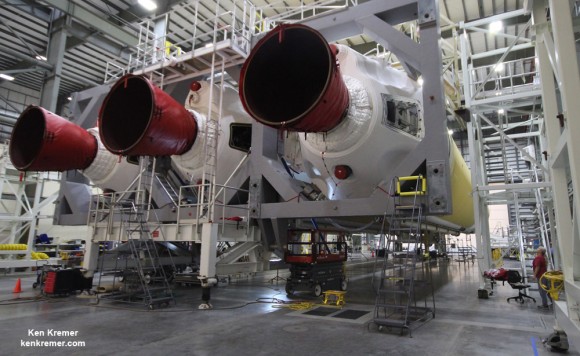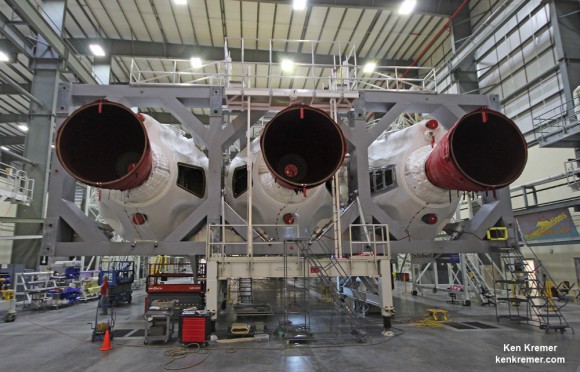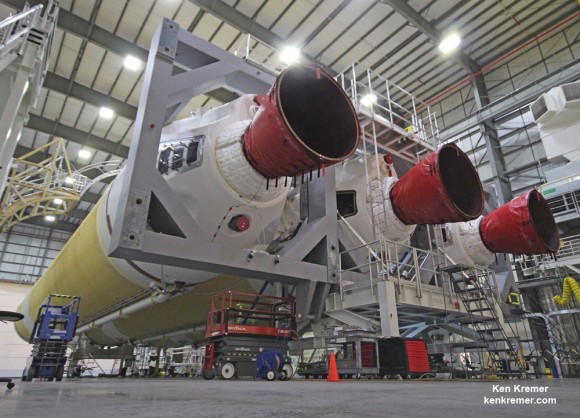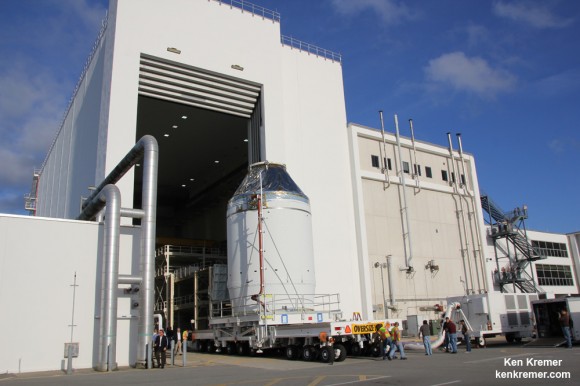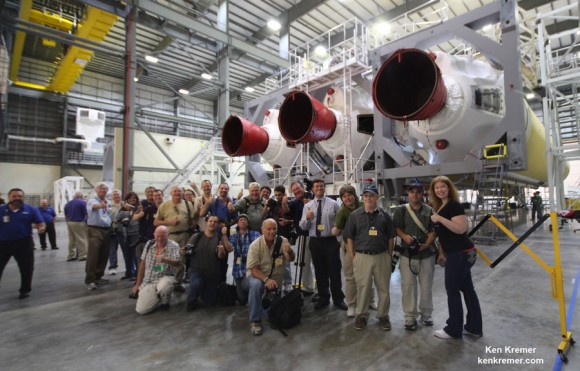Construction of Texas launch site to begin next year
BY STEPHEN CLARK
SPACEFLIGHT NOW
September 28, 2014

BROWNSVILLE, Texas -- SpaceX broke ground on a new commercial spaceport Sept. 22 on the shores of South Texas, committing to the construction of the world's first privately-owned satellite launch pad scheduled to be operational as soon as late 2016.

Rep. Filemon Vela, D-Texas, SpaceX CEO Elon Musk and Texas Gov. Rick Perry break ground on the South Texas spaceport. Credit: Stephen Clark/Spaceflight Now
The ceremonial groundbreaking, attended by more than 100 state and local officials, SpaceX employees, and media representatives, marked the end of a nationwide search for a location to build a new launch base for SpaceX's Falcon rocket family.
"This is just the first initial groundbreaking," said Elon Musk, CEO and chief designer at SpaceX. "It's going to take several years to build out the spaceport. This is going to be quite a significant building endeavor."
SpaceX initially plans up to a dozen launches of its Falcon 9 and Falcon Heavy rockets from the facility at Boca Chica Beach, a remote stretch of shoreline about three miles north of the U.S.-Mexico border at the mouth of the Rio Grande River.
Situated where a little-traveled two-lane highway dead-ends at the Gulf of Mexico about 20 miles east of Brownsville, the South Texas launch site beat out proposed locations in Florida, Hawaii and elsewhere.
"We looked all through the country, we looked at all possibilities," Musk said. "And I have to say we thought this was the best place to put it."
http://www.spaceflightnow.com/news/n1409/28brownsville/musk_brownsville.mp4
SpaceX CEO and chief technology officer Elon Musk speaks with reporters following the Sept. 22 groundbreaking in South Texas. Credit: Spaceflight Now
Texas lured SpaceX to the Rio Grande Valley with commitments of public funding and legislation to tweak laws that could impede launch operations at the site.
The state offered $15.3 million in incentives to support SpaceX's development of a South Texas spaceport, and the Texas legislature passed a law permitting the closure of public beaches on launch days.
"We put into account various factors, and one of the biggest factors -- maybe the biggest -- was the willingness of the state and local governments to support such an endeavor," Musk said. "Do they truly really want it? We want to be in a place where we're truly wanted."
The University of Texas at Brownsville and SpaceX are partnering to develop a ground communications station to support launches from the area.
The Federal Aviation Administration will license SpaceX's rocket launches from South Texas, holding responsibility for public safety. The U.S. Air Force does that job at Cape Canaveral and Vandenberg Air Force Base, Calif.
The FAA gave a green light to the commercial launch base in July after a review of its impacts to the environment.
"We actually began environmental studies on a few different locations, but I think the fundamental point that swayed SpaceX on Boca Chica was the tremendous outpouring of support from local residents," Musk said.
"Elon ... we thank you for having the vision to see that this is where you needed to be and wanted to be," said Texas Gov. Rick Perry. "This is just another one of those signals to the rest of the world that this is a state that is making a difference -- making a difference in a powerful way."
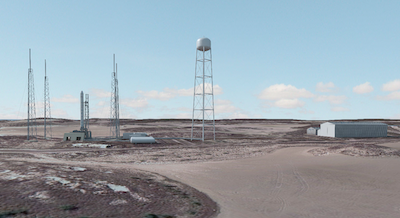
Artist's concept of the SpaceX launch pad in South Texas. Credit: SpaceX
Officials hope the SpaceX launch base will revitalize South Texas, an agglomeration of border towns with an economy primarily based on agriculture, tourism and maritime services.
"When you think about this project and what it means for the state of Texas, for the nation, and frankly for the world, then we start to see just how important Texas and the Rio Grande Valley is in that makeup," Perry said.
"In terms of SpaceX, in the three-to-four year timeframe, we expect to spend on the order of about $100 million," Musk said. "But in the long term, say in 10 or 20 years, it's probably in the several hundred million dollar range because we'll be expanding the facility, and there will be other companies that will locate here to support SpaceX. There will be an ecosystem of companies that will move in to support the anchor tent -- in this case, a commercial launch pad for commercial satellites."
The FAA approved up to 12 launches from the South Texas spaceport annually, including two flights of SpaceX's larger Falcon Heavy rocket. Most of the launches must occur in daylight, according to the FAA, with a possibility of one night launch per year.
While the FAA reviewed environmental concerns and state officials put together an incentive package, legislators rewrote laws to bring SpaceX to Texas.
"The issue that we would close Texas beaches for any private venture was against the laws of the state of Texas," said Rene Oliveira, who represents Brownsville in the Texas House of Representatives. "We have an Open Beaches Act, and that had to be modified.
The new law prohibits beach closures -- and launches -- on holidays and weekends in the summer.
"What we did is we'll close the beaches for hopefully one time a month," Oliveira said. "It did not allow that our friends at SpaceX could launch on holidays, which was very important, particularly to our culture. They like their beach and they're going to have their beach on Memorial Day, the Fourth of July and Labor Day. But it will be closed for one launch per month for 15 hours."
SpaceX plans to build a launch pad, a rocket integration hangar, propellant tanks, a launch control center, and a satellite processing clean room at the Boca Chica site.
Musk said preliminary work will begin soon, but major construction will not start until the second half of 2015, once SpaceX's launch site development team finishes modifications to Kennedy Space Center's launch pad 39A, which the company leased from NASA in April.
"We're expecting the Cape site to be done in approximately nine months, and we'll do some advanced preparation work here at Boca Chica, but we'll probably start with more significant activity in the third quarter of next year," Musk said.

SpaceX plans to build its launch pad on the left (south) side of Texas State Highway 4 in this view from the beach. Credit: Stephen Clark/Spaceflight Now
The first launch from South Texas could occur as soon as late 2016, according to Musk, who added SpaceX wants to base commercial communications satellite launches into geostationary transfer orbit from the Boca Chica facility.
"Our preference is to try to move particularly the commercial GTO (geostationary transfer orbit) missions to the Boca Chica launch site as soon as we can because there's a significant benefit by being south," Musk said.
Geostationary transfer orbit -- an elliptical orbit with a high point typically about 22,300 miles above Earth -- is a common drop-off point for large communications satellites.
Communications satellites use on-board thrusters to circularize their orbits at geostationary altitude -- 22,300 miles -- and move over the equator, where their orbital velocity matches the speed of Earth's rotation, causing the spacecraft to hover over a fixed location on the planet.
Rockets launching into such orbits receive a performance boost from launch pads at lower latitudes because of the faster spin of Earth closer to the equator. Launching closer to the equator allows rockets to use less fuel to put satellites in orbit.
"We're two-and-a-half degrees south of Cape Canaveral, and those two-and-a-half degrees are actually helpful for GTO missions," Musk said. "We have a strong incentive to try to get Boca Chica active as soon as possible."
The Boca Chica launch site lies at about 26 degrees north latitude, while Cape Canaveral sits at approximately 28.5 degrees.
SpaceX's rockets will launch to the east from Boca Chica Beach, flying over the Gulf of Mexico and the Florida Straits between the Florida Keys and Cuba to avoid flying over land en route to geostationary transfer orbit with commercial satellites.
Musk said SpaceX will continue using its launch pads at Cape Canaveral and Vandenberg Air Force Base in California primarily for U.S. government missions.
"I think this is really going to be a new kind of spaceport that's optimized for commercial operations," Musk said. "Cape Canaveral and Vandenberg are great launch sites, but they are military launch sites, so they're optmized more for defense of the country and that kind of thing.
"What's important for the future of space exploration is to have a truly commercial launch site, just as we have commercial airports," Musk said. "When you travel somewhere, from Dallas to New York or London, you're always landing at a commercial airport."
Musk said commercial astronaut crews could blast off from South Texas in the future, too. But NASA astronauts, such as crews heading for the International Space Station, will fly from SpaceX's facility at the Kennedy Space Center, he said.
"This is not in any way a knock on Cape Canaveral or [Kennedy Space Center]. That's a great spaceport that they've got there," Musk said. "It will continue to be used heavily as far into the future as one can imagine, but what we see is a level of demand in terms of launches that even Cape Canaveral could not support, so we needed another great launch site in order to support the flight rate that we expect."


